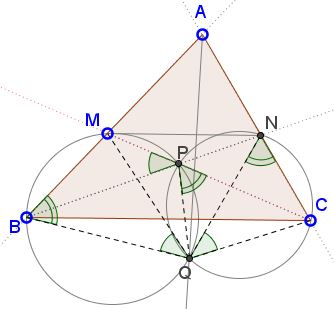Symmedian via Parallel Transversal and Two Circles
What Is This About?
Problem
Let $MN\;$ be a transversal parallel to the side $BC\;$ of $\Delta ABC,\;$ with $M\;$ on $AB\;$ and $N\;$ $AC.\;$ The lines $BN\;$ and $CM\;$ meet at point $P.\;$ The circumcircles of triangles $BMP\;$ and $CNP\;$ meet at two distinct points $P\;$ and $Q.\;$

Prove that the line $AQ\;$ is the $A\text{-symmedian}\;$ of $\Delta ABC.$
Proof
Consider triangles $BQM\;$ and $NQC:$

We start with angle chasing:
(1)
$\angle BQM=\angle BPM=\angle CPN=\angle CQN.$
Also,
(2)
$\angle MBQ=180^{\circ}-\angle MPQ=\angle CPQ=\angle CNQ.$
Form (1) and (2), triangles $BQM\;$ and $NQC\;$ are similar and their respective elements are proportional. It follows that
$\displaystyle\frac{dist(Q,AB)}{dist(Q,AC)}=\frac{dist(Q,BM)}{dist(Q,CN)}=\frac{BM}{CN}=\frac{AB}{AC},$
implying that $AQ\;$ is indeed the symmedian in $\Delta ABC\;$ through vertex $A.$
References
- Sammy Luo and Cosmin Pohoata, Let's Talk About Symmedians!, Mathematical Reflections 4 (2013), 1-11
Symmedian
- All about Symmedians
- Symmedian and Antiparallel
- Symmedian and 2 Antiparallels
- Symmedian in a Right Triangle
- Nobbs' Points and Gergonne Line
- Three Tangents Theorem
- A Tangent in Concurrency
- Symmedian and the Tangents
- Ceva's Theorem
- Bride's Chair
- Star of David
- Concyclic Circumcenters: A Dynamic View
- Concyclic Circumcenters: A Sequel
- Steiner's Ratio Theorem
- Symmedian via Squares and a Circle
- Symmedian via Parallel Transversal and Two Circles
- Symmedian and the Simson
- Characterization of the Symmedian Point with Medians and Orthic Triangle
- A Special Triangle with a Line Through the Lemoine Point
|Contact| |Front page| |Contents| |Algebra|
Copyright © 1996-2018 Alexander Bogomolny73511352
